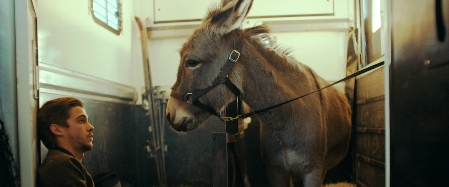
 The life story of a donkey, and his experiences under different human owners, is depicted to expand our ideas of what subjective life is to include animal life.
The life story of a donkey, and his experiences under different human owners, is depicted to expand our ideas of what subjective life is to include animal life.
Humility and innocence are difficult to portray well in fiction or drama. The imperfection of human beings means that artists will more readily create believable bad characters than good ones. But in our hearts we believe in the good, most of us, and in that way animals may come to symbolize for us our intuitions about natural goodness. Eo, the new film from veteran Polish director Jerzy Skolimowski, tells the story of a donkey.
Eo, spelled with just the letters E and O, is his name, or rather the name given to him by a young woman who is part of an animal act in a small Polish circus. The name imitates the sound donkeys make: think Eeyore from the Winnie-the-Pooh books. Anyway, the circus gets broken up because of animal welfare violations, and Eo is sent to a farm in the country where he is safe. But circumstances cause him to break through a fence, get lost in the woods, and then endure a lengthy series of human owners who range from friendly to careless, neglectful, and downright cruel.
Donkeys have long been associated with humility. In the New Testament, Jesus is said to have rode into Jerusalem on one, instead of the prouder and more imperious horse. You may have heard or read that Eo is a remake of Au Hasard Balthazar, a 1966 film by Robert Bresson. Yes, they share the same narrative device: following the life of a donkey as it goes through many owners. For Bresson, however, spirituality was impersonal, and his masterpiece conveys that vision of goodness that transcends human flaws. The story of Eo, however, is different. Skolimowski is more of a dramatist, for one thing, and his aim is to evoke the experience of life from the point of view of the donkey—a very difficult thing, impossible really, but in the effort of doing so in a film becomes tremendously moving. For all these reasons I don’t consider it a bona fide remake, since the conception is essentially of a separate kind.
The imagining of a donkey’s life journey is created through many different narrative and visual strategies. Eo endures everything that happens with the indomitable patience that, we are made to see, is a quality of his being rather than something that he learned. All the little human dramas that surround him during the course of the film, no matter how important they seem to the human characters, seem just paltry to us in the context of the stark awareness that is Eo’s experience. Domesticated animals, in whatever sense, are in a condition of slavery, and this fact takes on many profound nuances when we take the point of the view of the animal. The experience can be blissful, scary, indifferent, or incomprehensibly cruel, depending on the owners. Skolimowski’s purpose is to expand our own consciousness to include the subjectivity of animals, which in turn forces the narrow confinement of our human thoughts and purposes to open up, even just a little, to a more cosmic sense of reality.
At one crucial point in the story, a culminating moment of trauma, the film presents a nightmarish series of images contrasting our mechanistic and robotic attempts to imitate animal nature with the actual sensations of beings who are alive just like us. Eo presents the mirror of nature to our own sorry human condition, while at the same time planting our consciousness in a presence that is far greater than what we take for granted in our world: the presence of humility and innocence, in the tale of our failures and our fondest dreams.

